Lumpy skin disease (LSD) also known pseudourticaria, neethling virus disease, exanthema nodularis bovis, knopvelsiekte. Lumpy skin disease of Cattle and Water Buffalo caused by Capri pox virus belongs to family Pox viridae, Genus – Capri pox virus, Species-Lumpy skin disease virus also known as Neethling virus, other two species are Sheep pox virus and Goat pox virus. Capripox virus double stranded DNA virus and highly host specific. Hosts include Bos indicus, Bos torus and Bubalus bubalis (Water Buffalo). Virus can survive in desiccated crusts up to 35 days.
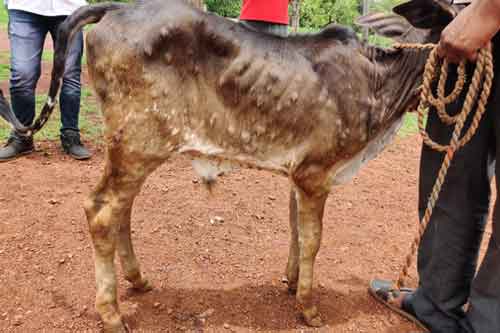
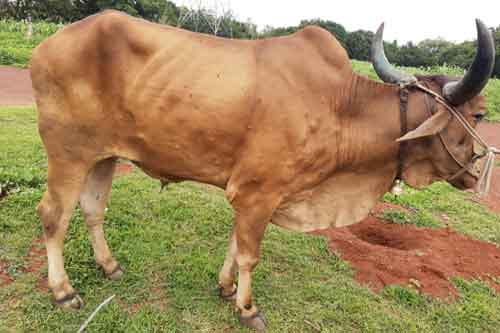
Epidemiology
The disease first reported in 1929 in Zambia, endemic in African countries. Since 2012 spreading rapidly through Middle east, South east, Europe, Ballans, Russia and Kazakhstan. Morbidity between 10-20 %. Mortality between 1-5 %, so morbidity is higher than mortality. LSD outbreaks can occurs up to 50 km radius. Infection will spreads faster in warm and wet weather and diminishes in winter weather. All age group animals are susceptible. Suckling calves can get infection from mother. Compared to Zebu Cattle cross breed animals are highly susceptible due to thin skin. The disease is more severe in lactating cows and young calves.
Economical importance
Permanent damage to skin, contagious and chronic nature of disease, fall in milk yield in lactating animals, severe emaciation, abortions, long standing anoestrus in affected female animals, poor growth in affected calves, prolonged treatment cost, managemental loss and disease predisposes to secondary pneumonia, peritonitis, mastitis, permanent lameness in bullocks, loss of draft power from lameness and rejection of export of livestock products leads to severe economical losses to farmers as well as nation due to trade restrictions.
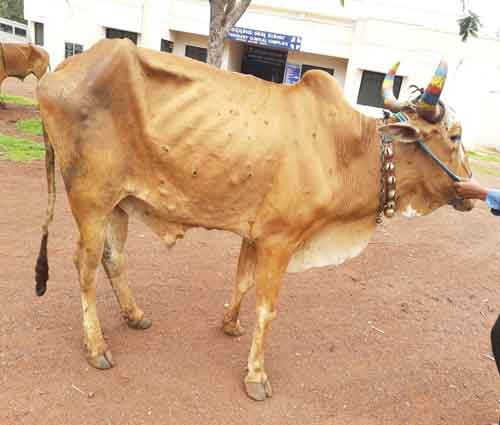
Lumpy skin disease in India
LSD first reported in India in Odisha state on 12 August 2019 and later to Jharkhand, West Bengal and Chatisgarh. In FEB 2020 reported in Telangana. In April 2020 reported in Karnataka and In June 2020 reported in Kerala. LSD is emerging and rapidly spreading disease in India.
Transmission
Disease transmitted by biting flies (Stomyxes spp), mosquitoes (Culex spp, Anopheles spp, Aedes spp), male ticks (Rhipicephalus spp, Amblyomma spp) direct contact, contaminated feed and water, also by iatrogenic transmission. Incubation period varies from 2 to 5 weeks. Vahicles and fomites also play an important role in disease transmission.
Zoonotic importance
Lumpy skin disease is not zoonotic disease.
Clinical signs
High body temperature (up to 106 F), swollen lymph nodes, nodules. lumps all over the body having size 2- 5 cm found mainly on face, neck, muzzle, nostrils, genitelia, eye lids, dewlap, udder, perineal region, tail, involving dermis, epidermis and sub cutaneous tissue. Nodules are circumscribed, firm, round, raised involves skin, sub cuteneous tissue and underlying muscles. Enlarged superficial lymph nodes. Nodules may anorexia, salivation, nasal discharges; fall in milk yield in females and loss of working capacity in male animals. After the course of disease these nodules becomes shrunken n slough from skin leading to ulcers formation, these ulcers complicated with secondary bacterial infections leading to pyogenic wounds or may be complicated into maggot wound. Vesicles, ulcers, erosions may develops in mouth leading to excessive salivation and anorexia. Virus found in blood after 7-10 days of infection. Corneal ulcers also found in some cases.
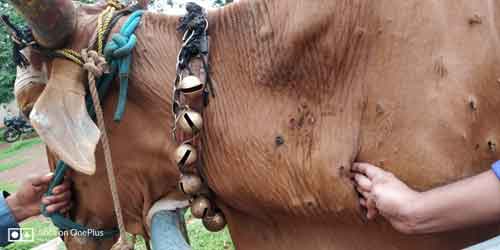
Effect on gastro-intestinal system
Nodules develops in mouth leads to oral cavity ulcers causing excessive salivation, anorexia and especially in abomasum leads to peritonitis, melana.
Effect on Respiratory system
Nodules develop in trachea causing excessive nasal discharge and nodules in the lung develop into pneumonia due to secondary bacterial infections.
Effect on muscle-skeletal system
In Lumpy skin disease edematous swelling occurs in limbs especially more prominent in hind limbs. Lameness occurs due to affection of inflammation of tendons. Severe swelling of brisket and legs occurs. Lameness may be permanent due to damage of tendons and arthritis complicated by secondary bacterial infection.
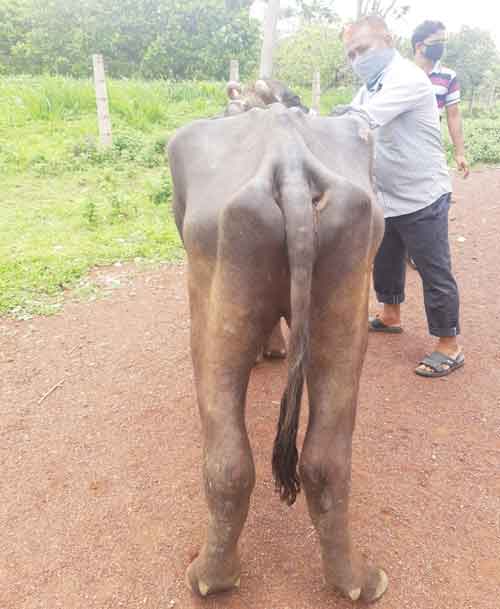
Effect on Reproductive System
In Lumpy skin disease affected pregnant animals will abort, milk yield will fall in lactating animals. Long standing Anoestrus will occurs in affected animals. Affected bulls will excrete virus in semen and will becomes temporary infertile. Infection transmission via coitus still not confirmed.
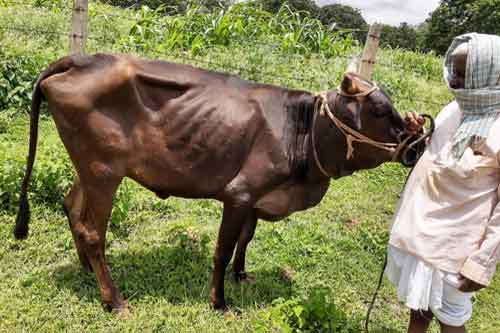
Samples
Skin lesion and scabs, saliva or nasal swabs, EDTA blood for PCR assay, whole blood for serum samples.
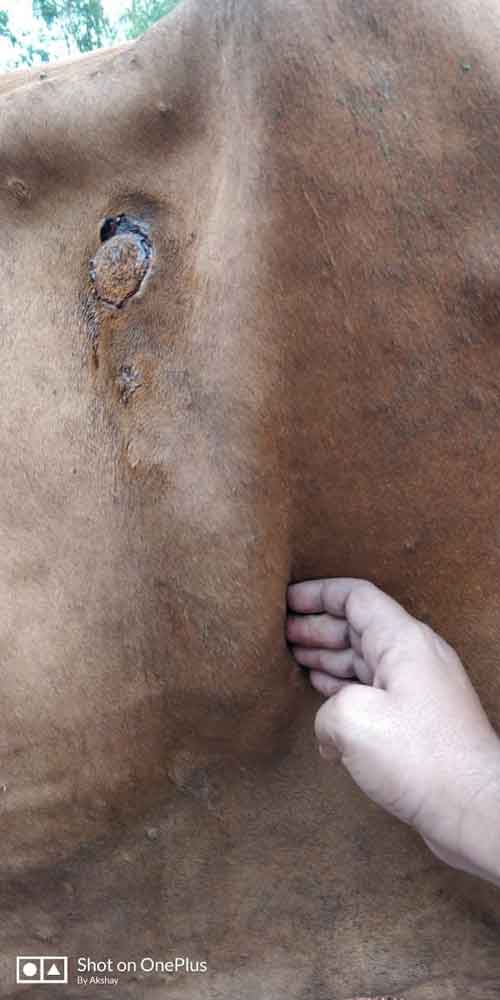
Diagnosis
- History of recently purchased from other states, districts or villages, history of biting by flies, ticks, mosquitoes.
- Based on clinical signs pyrexia, nodules all over the body having size 2 to 5 cm, Enlarged superficial lymph nodes, swollen limbs, salivation, anorexia, dullness, fall in milk yield in female animals.
- Isolation and identification of virus from skin nodules.
- Antigen testing done by direct immunofluroscent staining, virus neutralization test, ELISA antigen capture technique.
- Detection of LSD virus using PCR is quickest method of diagnosis.
- Histopathology of skin nodule biopsy.
- Electron microscopy.
- Calf inoculation.
- Post-mortem examination revels presence of nodules on skin and ulcers in the mucus membrane especially ulcers in Gastro-intestinal tract and in respiratory tract and signs of secondary pneumonia.
Differential diagnosis
- Pseudo-lumpy skin disease: caused by Bovine Herpes virus– 2. It will cause milder form of disease. Electron microscope will differentiate the both viruses.
- Bovine Herpes mammilitis: In these disease lesions are limited to teats and udder.
- Urticaria: generally cured with antihistiminics.
- Honey bee sting bite: History of honey bee attack and non uniform skin lesions.
- Bovine popular stomatitis caused by Bovine parapox virus: lesions confined to oral cavity.
- Demodecosis caused by Demodex bovis- skin scraping examination.
- Papillomatosis: good response to autohemotherapy and Antheomaline Inj.
- Hypoderma bovis infestation: Maggot wound management.
- Cuteneous tuberculosis: Acid fast staining.
- Skin form of Thelieriosis: Blood smear examination.
- Insect bite or tick bite.
- Photosensitisation: History of recent plant poisoning or medication n there will be elevation of hepatic enzymes.
Treatment
There is no specific treatment for Lumpy skin disease. Long acting anti-inflammatory agents should be given as the duration of the disease is more. Antihistamines to reduce the itching effect. Symptomatic treatment given in initial stage. Later broad spectrum long acting anti-biotics given to avoid the secondary bacterial complications. Zinc containing preparations, Multivitamins Injections and tablets or bolus are given for early recovery. Wound management should be done carefully to avoid the myiasis. Oral Liver tonics should be given.
Control measures
- Isolation and culling of severely affected animals and quarantine of affected farm.
- Elimination of vectors protects animals from insect bites and follows hygiene practices in the farm.
- Control of animal movement from endemic area to unaffected areas.
- Cattle fairs, shows and livestock markets like activities should be banned in affected areas.
- Proper disposal of carcass and disinfection of farm.
- Vaccination of healthy animals is the most effective control measure, live homogenous vaccine containing Neethling-like strain vaccine. This vaccine not available in India.
- In India heterologus Goat pox vaccine (Live attenuated virus vaccine) can be used for the control of disease, 1ml s/c route and given to healthy animals only. In case of outbreaks Ring vaccination to be done. Cold chain to vaccination is mandatory
- Change the needle after treatment of affected or suspected animal.
- Good nursing care.
References
- Fast facts : Lumpy skin disease- Center for food security and public health-Iowa University, 2011
- Lumpy skin disease- Pip Beard B.V.Sc PhD & MRCVS.
- Wikipedia
- MSD Veterinary manual.
- NADIS ANIMAL HEALTH SKILLS. National animal disease information service.
- cabi.org- lumpy skin disease







Good one
Nice one
Very nice and wounderful information
this article is impressive specially for the vet practioneer’s thankyou doctor, we hope more article from you.
Good information on right time..
Nice article sir
Good information. Expected such articles more in future.
Good one sir
Very informative article .nice
Dedicated to Veterinarians…
Nice Article
Nice article sir
Good article Dr.Annarao
Good information and very informative for the farmers .
very informative and useful article to field veterinarians ..
All the best Dr
Very nice information sir…
Informative and useful article for field vets
ತುಂಬ ಒಳ್ಳೆಯ ಬರಹ
nice article
Good job I appreciate sir thank you so muc
Great one Dr annaroa sir !
It’s newly encountering contaminated disease….good information sir
Good article sir ji
Good article
Nice and informativ article sir